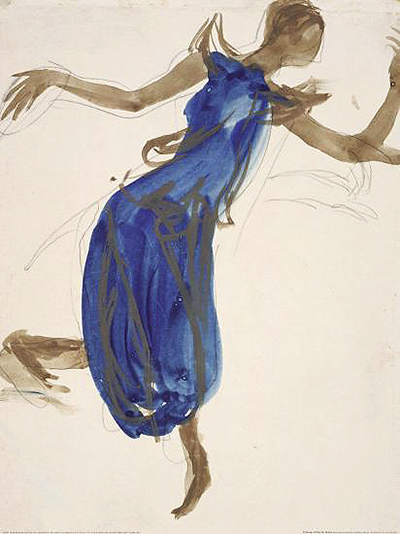Artists have a unique way of finding fascinating things in their surroundings, even when other individuals fail to see anything artistic. While an artist looks at the sunset and sees the beautiful hues contrasting each other, an ordinary person will see the seemingly orange colors letting go of daylight paving the way to the darkness ahead.
When a troupe of Cambodian dancers visited Southern France for their Royal Ballet accompanying the then Cambodian King; King Sisowath, on his official visit to the French nation, many people were in attendance, but one French sculptor and artist Auguste Rodin saw something more than the dancers' compelling dancing; a revelation of a culture's uniqueness. Enchanted by their graceful movements in utmost nobility, Rodin followed the troop to Marseilles for one primary reason, to get enough drawings of the dancers before they left France. Using his pencil and thick watercolor used for opaque painting, Rodin drafted several drawings of these dancers in various movements.
In one of the artist's paintings; Cambodian Dancer 1906, Rodin used a brownish-grayish ochre for the arms and head then opted for a thick blue color for the tunic. The thick strokes of the blue color on the painting in perfect contrast to the soft pencil lines gave the dancer an upright pose. Even though some of the critical details like the face and the hair are missing, one thing is for sure; the dancer's engaging and energetic movements are a sight to behold.
The portrayal of the graceful arms in their fluid movements is evident that the French artist was wowed by the Khmer dance. At some point, he opened up to Georges Bourdon on the dancers' impression on him in an article published the same year (1906). "There is an extraordinary beauty, a perfect beauty, about these slow, monotonous dances, which follow the pulsating rhythm of the music. The Cambodians have taught me movements I had never come across anywhere before. In short, if they are beautiful, it is because they have a natural way of producing the right movements."
Rodin's Most Famous Works
The non-impressionistic features in various versions of the Cambodian Dancer are Rodin's style of working on unfinished pieces. He was not so much interested in the mood and the beauty of the dancers, instead, all he wanted was to bring out the hands/arms and their pointing fingers topping up with the females' costumes.
Brother and Sister, I am Beautiful, Iris Messenger and The Walking Man are some of Rodin's sculptures that signify his love for his tactful unfinished pieces prowess though with his love for the human anatomy, he would complete most of his pieces including Crouching Woman, Youth Triumphant and Damned Women.
Though Rodin is famous for sculpting most of his works, he was also a top-notch professional with his paint, pencil, and brush and would give his paintings thick contrasting color strokes in perfect distinctions. Some of the famous paintings that famed this 18th Century French artist apart from the more than 150 copies of the Cambodian Dancer include Golden Twilight on the Dunes in the Forest of Soignes.
Cambodian Dancer Exhibition
In remembrance of Rodin's encounter with the Cambodian dancers, an exhibition was set up in 2006. This event brought to life the enthusiasm, love and the purity for the Khmer dance in expressing its movements: The sole reason why Rodin dropped everything he was engaged in to follow the troupe to wherever they traveled with their ruler King Sisowath 1st who had just been crowned. The drawings which were mostly of the ballet poses with an immense interest in the swaying of the dancers' hands and arms later got refined by using watercolors to highlight various harmonies.
Rodin's Mentors and Mentees
Having acquired some of his initial skills from his predecessors like Antonio Canova who is famous for Psyche Revived by Cupid's Kiss and The Three Graces and Michelangelo's Pieta and Madonna of the Steps, Rodin deviated way further into sculpting intriguing critique pieces. Even though he was eventually praised for his weightless floating sculptures, he received an equal measure of criticism. For instance, his sculptures, including Fugitive Love and Adonis Awakens.
Even though some of his works were criticized, Rodin did not know that some budding sculptors were looking up to him and would continue his legacy. Henri Matisse, a French artist though not a sculptor, also found his way into the human body but not too bold to bring out the euphoric passion personified by his predecessor. The furthest Matisse tried with the nude paintings were the Blue Nude he did in 1907 and the second version Blue Nudes in 1952.
Other works by Matisse include Woman with a Hat, Woman With a Purple Coat and The Young Sailor II. Rodin's Cambodian Dancer and several other of his famous works are preserved in his museum in France which was built way after he died to remind his fans of his sculptures and paintings. Auguste Rodin will forever be remembered for his famed sculptures in generations to come, not because of the built museum in his name for his works of art but for his seemingly controversial passionate and erotic sculptures that are finding refinement in polished bronze in various art galleries.




